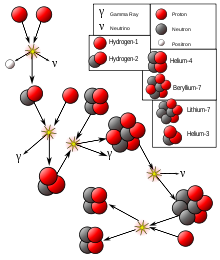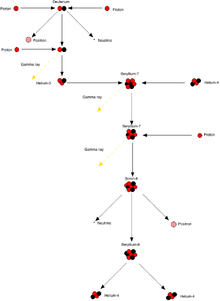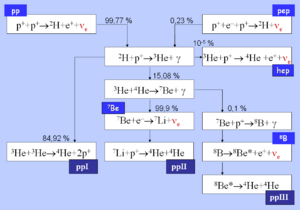- Proton–proton chain reaction
-
The proton–proton chain reaction is one of several fusion reactions by which stars convert hydrogen to helium, the primary alternative being the CNO cycle. The proton–proton chain dominates in stars the size of the Sun or smaller.
In general, proton–proton fusion can occur only if the temperature (i.e. kinetic energy) of the protons is high enough to overcome their mutual electrostatic or Coulomb repulsion.[1]
In the Sun, deuterium-producing events are rare enough (the vast majority of these events produces a diproton instead) that a complete conversion of its hydrogen would take more than 1010 (ten billion) years at the prevailing conditions of its core.[2] The fact that the Sun is still shining is due to the slow nature of this reaction; if it went more quickly, the Sun would have exhausted its hydrogen long ago.
Contents
History of the Proton-Proton Chain Reaction
The theory that proton–proton reactions were the basic principle by which the Sun and other stars burn was advocated by Arthur Stanley Eddington in the 1920s. At the time, the temperature of the Sun was considered too low to overcome the Coulomb barrier. After the development of quantum mechanics, it was discovered that tunneling of the wavefunctions of the protons through the repulsive barrier allows for fusion at a lower temperature than the classical prediction.
Even so, it was unclear how proton-proton fusion might proceed, because the most obvious product, helium-2 (diproton), is unstable and immediately dissociates back into a pair of protons. In 1939, Hans Bethe proposed that one of the protons could beta decay into a neutron via the weak interaction during the brief moment of fusion, making deuterium the initial product in the chain.[3] This idea was part of the body of work in stellar nucleosynthesis for which Bethe won the 1967 Nobel Prize in Physics.
The Proton-Proton Chain Reaction
The first step involves the fusion of two hydrogen nuclei 1
H (protons) into deuterium, releasing a positron and a neutrino as one proton changes into a neutron.This first step is extremely slow, both because the protons have to tunnel through the Coulomb barrier and because it depends on weak interactions.
The positron immediately annihilates with an electron, and their mass energy, as well as their kinetic energy, is carried off by two gamma ray photons.
After this, the deuterium produced in the first stage can fuse with another hydrogen to produce a light isotope of helium, 3
He:From here there are three possible paths to generate helium isotope 4
He. In pp I helium-4 comes from fusing two of the helium-3 nuclei produced; the pp II and pp III branches fuse 3
He with a pre-existing 4
He to make beryllium. In the Sun, branch pp I takes place with a frequency of 86%, pp II with 14% and pp III with 0.11%. There is also an extremely rare pp IV branch.The pp I branch
The complete pp I chain reaction releases a net energy of 26.7 MeV. The pp I branch is dominant at temperatures of 10 to 14 MK. Below 10 MK, the PP chain does not produce much 4
He.[citation needed]The pp II branch
See also: lithium burningThe pp II branch is dominant at temperatures of 14 to 23 MK.
90% of the neutrinos produced in the reaction 7
Be(e−
,ν
e)7
Li* carry an energy of 0.861 MeV, while the remaining 10% carry 0.383 MeV (depending on whether lithium-7 is in the ground state or an excited state, respectively).The pp III branch
The pp III chain is dominant if the temperature exceeds 23 MK.
The pp III chain is not a major source of energy in the Sun (only 0.11%), but was very important in the solar neutrino problem because it generates very high energy neutrinos (up to 14.06 MeV).
The pp IV or Hep
This reaction is predicted but has never been observed due to its great rarity (about 0.3 ppm in the Sun). In this reaction, Helium-3 reacts directly with a proton to give helium-4, with an even higher possible neutrino energy (up to 18.8 MeV).
Energy release
Comparing the mass of the final helium-4 atom with the masses of the four protons reveals that 0.007 or 0.7% of the mass of the original protons has been lost. This mass has been converted into energy, in the form of gamma rays and neutrinos released during each of the individual reactions. The total energy yield of one whole chain is 26.73 MeV.
Only energy released as gamma rays will interact with electrons and protons and heat the interior of the Sun. This heating supports the Sun and prevents it from collapsing under its own weight.
Neutrinos do not interact significantly with matter and do not help support the Sun against gravitational collapse. The neutrinos in the ppI, ppII and ppIII chains carry away 2.0%, 4.0% and 28.3% of the energy in those reactions respectively.[4]
The pep reaction
Deuterium can also be produced by the rare pep (proton–electron–proton) reaction (electron capture):
In the Sun, the frequency ratio of the pep reaction versus the pp reaction is 1:400. However, the neutrinos released by the pep reaction are far more energetic: while neutrinos produced in the first step of the pp reaction range in energy up to 0.42 MeV, the pep reaction produces sharp-energy-line neutrinos of 1.44 MeV.
Both the pep and pp reactions can be seen as two different Feynman representations of the same basic interaction, where the electron passes to the right side of the reaction as an anti-electron. This is represented in the figure of proton–proton and electron-capture chain reactions in a star, available at the NDM'06 web site.[5]
See also
References
- ^ Ishfaq Ahmad, The Nucleus, 1:42,59, (1971), The Proton type-nuclear fission reaction
- ^ Kenneth S. Krane, Introductory Nuclear Physics , Wiley , 1987, p. 537.
- ^ Hans A. Bethe, Physical Review 55:103, 434 (1939); cited in Donald D. Clayton, Principles of Stellar Evolution and Nucleosynthesis, The University of Chicago Press, 1983, p. 366.
- ^ Claus E. Rolfs and William S. Rodney, Cauldrons in the Cosmos, The University of Chicago Press, 1988, p. 354.
- ^ Int'l Conference on Neutrino and Dark Matter, Thursday 07 Sept 2006, http://indico.lal.in2p3.fr/getFile.py/access?contribId=s16t1&sessionId=s16&resId=1&materialId=0&confId=a05162 Session 14.
Nuclear processes Radioactive decay Stellar nucleosynthesis pp-chain · CNO cycle · α process · Triple-α · Carbon burning · Ne burning · O burning · Si burning · R-process · S-process · P-process · Rp-process
Other processes EmissionCaptureCategories:
Wikimedia Foundation. 2010.




